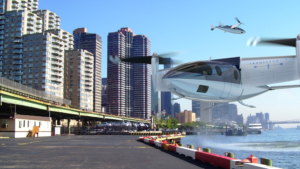By: Dawn M.K. Zoldi
Sick of the current airline model, where you have to leave your house at least 3 hours earlier than your flight, wait around for what seems like an eternity on both ends of your flight, only to experience yet another painful wait plus ground commute on the back end? Peter Schmidt, Co-Founder and Chief Operating Officer, Transcend Air, a vertical takeoff and landing (VTOL) company, discusses how his team plans to upend this model and transform the city-to-city travel model with their award-winning Vy aircraft.
Schmidt formed the company, based on his years of experience with regional airlines, with service in mind. “VTOL aircraft need accessible infrastructure and, more importantly, an affordable and quality service model, to positively impact society and solve the current city-to-city mobility problem,” he explains.
That problem includes airports themselves, which are built around centralized hubs that require treks through already heavily congested cities and add hours on each end to the commute. Additive to the ground commute, once at the airport, travelers must spend even more time waiting around at the airport. “Airports are money makers. They have become retail mall experiences and eateries to make the wait a little less painful. They’ve added on hotels and car rental dealerships because of the time and ground travel associated with air travel. Unfortunately, many advanced air mobility (AAM) companies have created models that incorporate glorified airports for VTOL, which they call vertiports. This won’t solve the true mobility problem.” says Schmidt.
Transcend has created a three step model to challenge the status quo. Step 1, they will have no airports. The company will operate from a distributed architecture, floating base structures called Vy Ports. These launchpads will alleviate the need for commercial ground travel because they will be walking distance from city centers. Accessibility in every respect, is the name of the game for Transcend. They have designed both their Vy Ports and their aircraft to be accessible for everyone, including those with physical disabilities.
Speaking of design, Steps 2 and 3 involve the aircraft itself. Step 2 is the Vy 400’s VTOL design, which enables it to takeoff/land flexibility to and from these urban Vy Ports. According to Schmidt, “VTOL gives us access to the demand-rich centers of cities, where we can offer a useful schedule at competitive prices.”
Step 3 is its tiltwing, which allows it to fly at speeds upwards of 400mph. This is three times faster than helicopters. Schmidt says, “Speed saves money through increased efficiency. The Vy can do more trips per day than a helicopter, and that keeps prices down.” The Vy will take commuters from San Francisco to San Diego in and an hour and twenty minutes. Incredibly, this will be accomplished at 50% of the cost-per-mile required by a helicopter – that would take nearly four hours for the trip. Similarly, at a projected $283 one way from Boston to New York City, the Vy undercuts the door-to-door cost of the typical ground travel plus regional airline fare combination required to fly today. In December 2020, independent industry expert Abbott Aerospace Canada ranked the Vy 400 #1 of 220 advanced aircraft designs.
“This city-to-city air travel market is where our heart is at Transcend. But we are disrupting two other key markets as well,” Schmidt elaborates. The first is the $4.5B executive helicopter market. Transcend created the Vy 400R, Reserved Edition, VIP design which the Robb Report, the leading voice of global luxury markets, rated as the 2020 “Best of the Best” VTOL concept in aviation. The roomy Vy 400R provides a better-than-first-class interior at half the price, three times the speed, and one-quarter the operating costs of the nearest-peer medium twin executive helicopter.
The Vy has also made its military market debut. The United States Air Force AFWERX and Special Operations Command are looking to Transcend to revolutionize personnel recovery missions to rescue downed soldiers, sailors, airmen and Marines on the battlefield. Two weeks ago AFWERX announced a new High Speed VTOL challenge, in which Transcend expects to play a critical role. Schmidt says “The U.S. has been losing in simulated war games against near peer first world enemies. They will take out our runways. The military needs VTOL aircraft that can launch from almost anywhere, to evolve beyond runway dependence. The Vy is 133% faster than a V-22 Osprey to start, and will be upgradeable to go 500mph using engines already in development. With that speed, it can rescue people from a six-times larger operating area than helicopters can.”
Whether it is city-to-city or field hospital to rescue location, the Vy seeks to transcend the competition. For more information contact Peter and the Transcend Air team at contact@transcend.aero.
 Dawn M.K. Zoldi (Colonel, USAF, Retired) is a licensed attorney with 28 years of combined active duty military and federal civil service to the Department of the Air Force. She is an intIernationally recognized expert on unmanned aircraft system law and policy, a columnist for several magazines,recipient of the Woman to Watch in UAS (Leadership) Award 2019, President and CEO of UAS Colorado and the CEO of P3 Tech Consulting LLC. For more information, visit her website at: https://www.p3techconsulting.com.
Dawn M.K. Zoldi (Colonel, USAF, Retired) is a licensed attorney with 28 years of combined active duty military and federal civil service to the Department of the Air Force. She is an intIernationally recognized expert on unmanned aircraft system law and policy, a columnist for several magazines,recipient of the Woman to Watch in UAS (Leadership) Award 2019, President and CEO of UAS Colorado and the CEO of P3 Tech Consulting LLC. For more information, visit her website at: https://www.p3techconsulting.com.

Miriam McNabb is the Editor-in-Chief of DRONELIFE and CEO of JobForDrones, a professional drone services marketplace, and a fascinated observer of the emerging drone industry and the regulatory environment for drones. Miriam has penned over 3,000 articles focused on the commercial drone space and is an international speaker and recognized figure in the industry. Miriam has a degree from the University of Chicago and over 20 years of experience in high tech sales and marketing for new technologies.
For drone industry consulting or writing, Email Miriam.
TWITTER:@spaldingbarker
Subscribe to DroneLife here.








[…] Source link […]